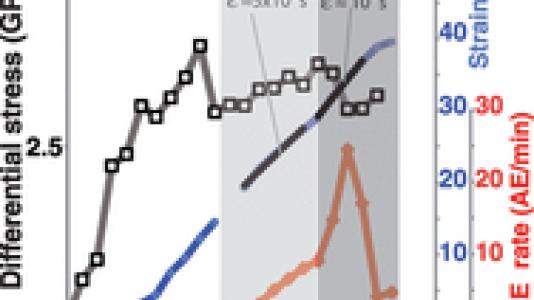
More than 20 years ago, geologists discovered a high-pressure failure mechanism that they proposed was the long-sought cause of very deep earthquakes occurring at a depth of more than 400 kilometers (or 248 miles). The result was controversial because seismologists could not find a seismic signal in the Earth that could confirm the results.
Seismologists have now found the critical evidence. Indeed, beneath Japan, they have even imaged the tell-tale evidence and showed that it coincides with the locations of very deep earthquakes.
In the September 20 issue of the journal Science, a team of researchers from Centre National de la Recherche Scientifique; Université de Lille; The University of Chicago; and the University of California, Riverside show how such deep earthquakes can be simulated in the laboratory.
They confirmed essentially all aspects of the earlier experimental work and extended the conditions to significantly higher pressure. These experiments were accomplished using synchrotron x-rays in what the researchers call the “premier laboratory in the world for this kind of experiments,” the U.S. Department of Energy Office of Science’s Advanced Photon Source (APS) at Argonne National Laboratory.
The origin of deep earthquakes fundamentally differs from that of shallow earthquakes (earthquakes occurring at less than 50-kilometers depth). In the case of shallow earthquakes, theories of rock fracture rely on the properties of coalescing cracks and friction.
But as pressure and temperature increase with depth, intracrystalline plasticity dominates the deformation regime so that rocks yield by creep or flow rather than by the kind of brittle fracturing we see at smaller depths. Moreover, at depths of more than 400 kilometers, the mineral olivine, a magnesium iron silicate, is no longer stable and undergoes a transformation resulting in spinel, a mineral of higher density
The research team focused on the role that phase transformations of olivine might play in triggering deep earthquakes. They performed laboratory deformation experiments on olivine at high pressure and high temperature utilizing high-brightness x-ray beams at the GeoSoilEnviroCARS x-ray facility at the APS. They found the “earthquakes” only within a narrow temperature range that simulates conditions where the real earthquakes occur in Earth.
Moreover, they found that fractures nucleate at the onset of the olivine to spinel transition, and these fractures propagate dynamically so that intense acoustic emissions are generated. These phase transitions in olivine, they argue in their research paper, provide an attractive mechanism for how very deep earthquakes take place.
Reference: Alexandre Schubnel* Fabrice Brunet, Nadège Hilairet, Julien Gasc, Yanbin Wang, and Harry W. Green II, “Deep-Focus Earthquake Analogs Recorded at High Pressure and Temperature in the Laboratory,” Science 341, 1377 (20 September 2013). DOI:10.1126/science.1240206